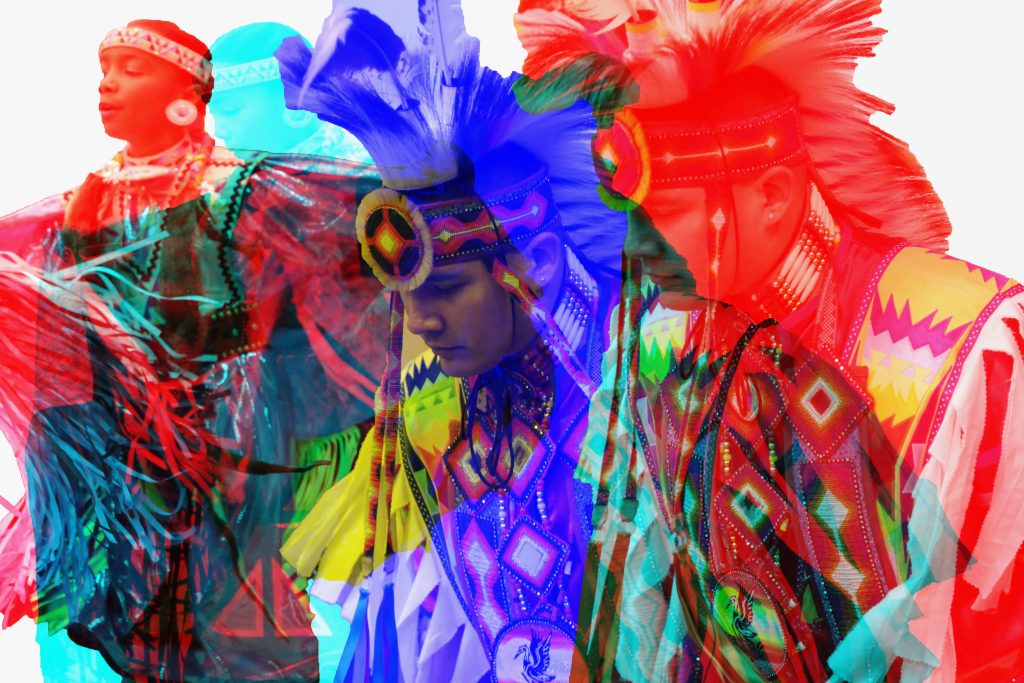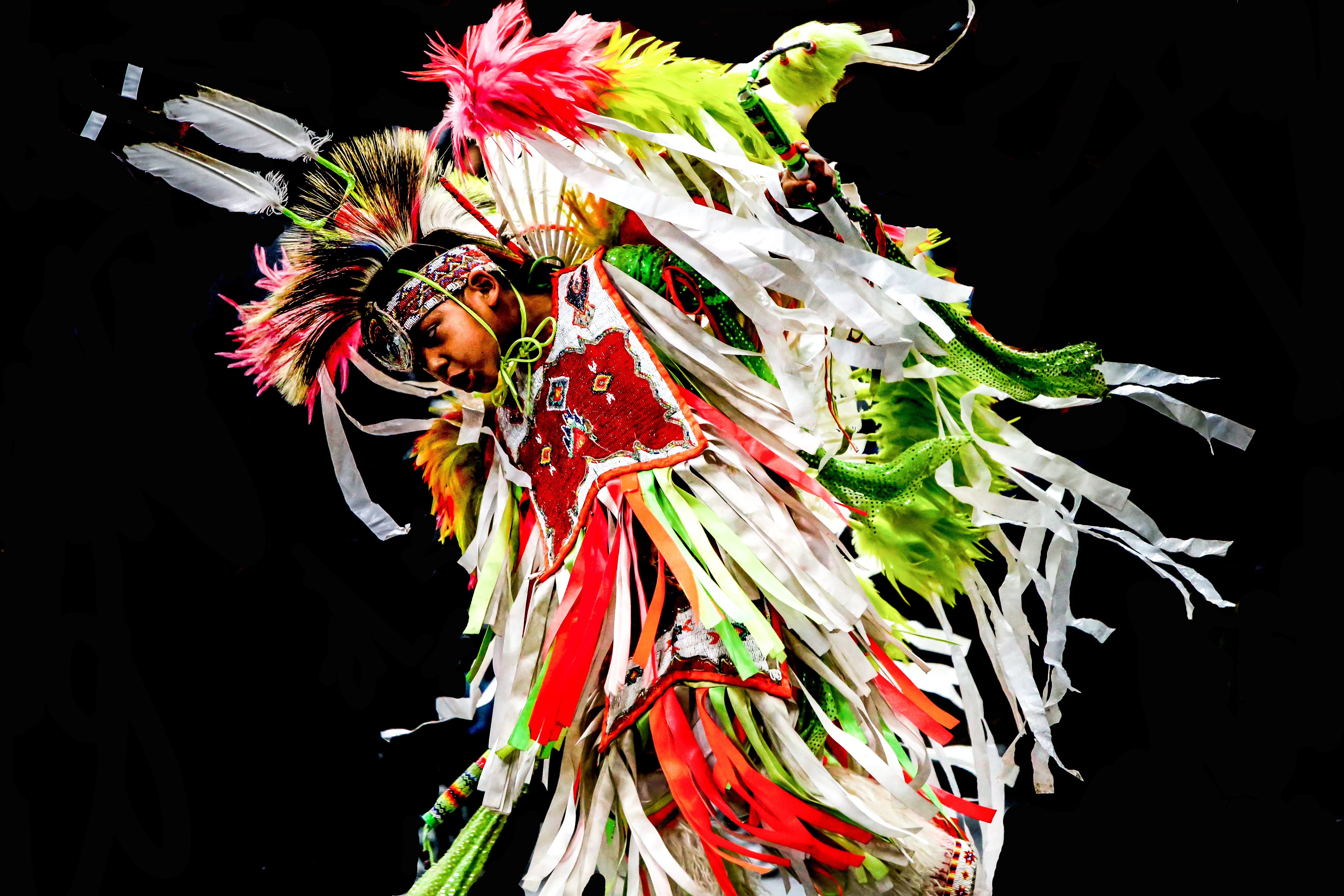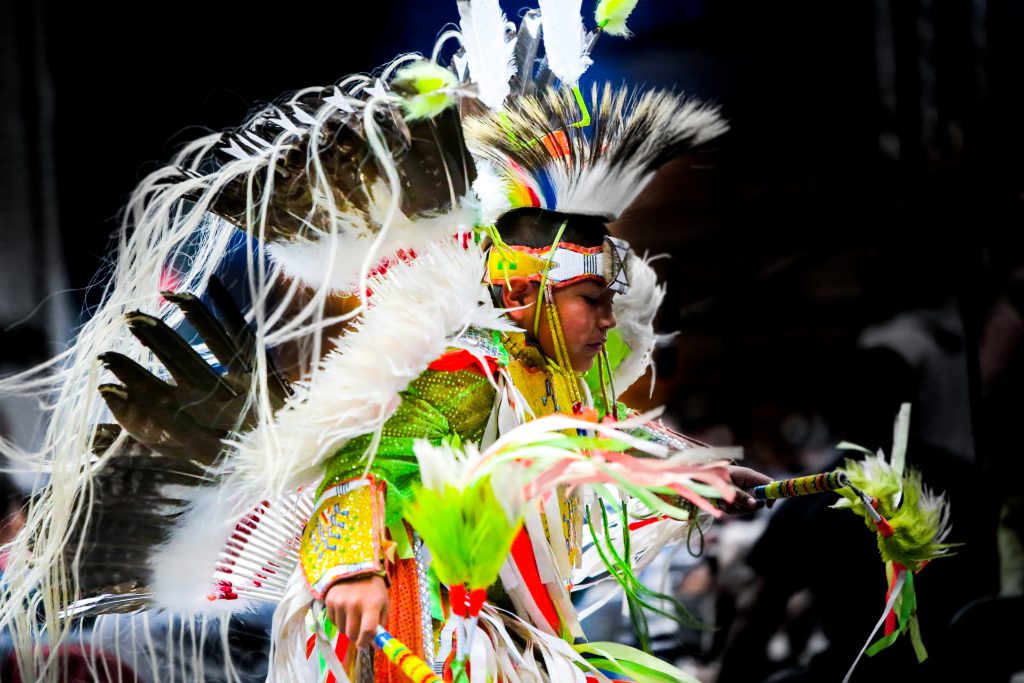Every dollar the members of the Ho-Chunk Nation receive after graduation represents an opportunity for progress
Photographed by Katie Scheidt
Gabrielle White dances alongside her sisters to the beat of the Bear Trail drum group.
Her hair is pulled back into a tight braid, and she has traded her typical outfit of jeans and a T-shirt for a traditional Native American jingle dress, complete with an eagle feather and intricate beading.
White has been dancing Ho-Chunk appliqué, a traditional style of dance that gets its name from the floral designs appliqued on the dresses of Ho-Chunk females, for as long as she can remember. But this performance is different. She is dancing for the students of DeLong Middle School in Eau Claire.
 The performance itself is exciting, but what might be even more compelling is how some young Ho-Chunk adults are using a financial benefit through a tribal trust fund to invest in their future. For two cultures that both inhabit Wisconsin, the sharing of traditions is not as common as it could be.
The performance itself is exciting, but what might be even more compelling is how some young Ho-Chunk adults are using a financial benefit through a tribal trust fund to invest in their future. For two cultures that both inhabit Wisconsin, the sharing of traditions is not as common as it could be.
One of those young adults is White’s sister Ashley Rave, who received roughly $200,000 through the Ho-Chunk Nation’s Children’s Trust Fund Program. The check allowed Rave to attend college at UW-Milwaukee with the hope of becoming an art teacher. For Rave’s final semester, she is student teaching at DeLong, and her work at the school allowed her to organize the dance performance.
The Children’s Trust Fund is a Ho-Chunk Nation program that gives members of the tribe about $200,000 when they turn 18, graduate from high school and complete a newly implemented financial literacy course.
The program has a negative reputation due to stories of members spending the funds irresponsibly, but this money represents an incredible opportunity for those who receive it. With every pull of a slot machine comes the chance to improve not only the Ho-Chunk community, but also Wisconsin as a whole. In some cases, these funds have helped two cultures converge, and this unity makes for positive progress.
The Ho-Chunk Nation consists of 7,700 members, each of whom receive $12,000, primarily from casino revenue, every year. This check is mandated by the Per Capita Distribution Ordinance, a part of tribal law that dictates how much money goes to the people and how it is distributed. Roughly 80 percent of the Ho-Chunk Nation’s profit is distributed back to its members.
For members of the Nation who are younger than 18, this money is held in a trust. Once a member meets the mandated requirements, he or she can access the trust. The amount of money in the trust depends on when a person is enrolled, but it can reach as much as $216,000.
Non-Native American media sometimes use the term “18 money” to describe the Children’s Trust, which has contributed to negative connotations of the program.
Professor Richard Monette, the faculty director of the Great Lakes Indian Law Center, says when the news media report rare, outlier stories about people who use their money irresponsibly — driving fast cars and doing drugs, for example — this narrative can create a self-fulfilling prophecy. But the majority of Wisconsin tribes have overcome this negative rhetoric and have found positive ways to spend the money, he says.
“For the most part, the Native nations in our area have used this money very wisely, either as a collective nation, a government … or individually,” Monette says. “We have kids that are using their money to go to college.”
White, 26, used part of her trust fund to attend college, but she concedes that it caused tension with her mother. They had different ideas about how the money should be spent, and neither had experience handling a large amount of money.
“It was really overwhelming to receive that much money and have no background of any kind in budgeting,” White says.
Collin Price, the Ho-Chunk Nation public relations officer, says for some of the children who are growing up below the poverty line, receiving this money can be daunting. They may need guidance on how to make sound financial decisions, so they don’t inadvertently fall back into a cycle of poverty.
Price says tribal legislators are aware of this potentially dangerous cycle and are constantly trying to improve the system.
Michelle Cloud, manager of the Ho-Chunk’s Culture and Community Education Division, says the tribal legislators revised the law to mandate that everyone must pass a financial literacy course before they receive their money. The tribal government believes this new requirement will help members gain skills they need to responsibly handle their trust funds.

The program launched in October 2016 and consists of 14 tutorials, which take about 20 to 25 hours to complete. Cloud says students are required to score at least 70 percent on the final exam at the end of the course. Members may take the test as many times as necessary to pass, but they must wait two weeks between each attempt.
The course covers a range of money-related issues, such as budgeting, investing and filing taxes, and offers information about employment and education options specific to the Ho-Chunk Nation. For example, it describes how to access the Ho-Chunk government’s Department of Higher Education and file taxes on their per capita distribution funds.
Cloud says since the program’s implementation, there have been fewer people receiving access to their trust.
Joy Snake, a project manager for the Ho-Chunk Nation Education Department, attributes part of this decrease to some students feeling as though they are not ready for the responsibility that comes with having that much money.
“[But] then they go through the program, and they are thankful … because it opened their eyes to different options and resources that they didn’t even think about,” Snake says.

White wishes the program had been a requirement when she received her trust because she believes she would have been able to thrive in college the first time she attended. She originally enrolled at UW-Milwaukee, but took a few years off to decide on a major. During her time off, White worked for her tribe as an aide in the Ho-Chunk’s Office of the President.
While working, White noticed the Ho-Chunk Nation had a lack of mentors and role models in the community. This realization inspired her to use the remainder of her trust fund to go back to school at UW–Eau Claire and earn a psychology degree.
“I’ve noticed there needed to be more role models for the Ho-Chunk youth to prepare them more for college,” White says. Going back to school was a way of “giving back to the community and trying to make things better for my tribe.”
In addition to going to school, White has been interning at UW–Eau Claire’s Office of Multicultural Affairs, speaking at events and creating a mentorship program to help Ho-Chunk youth transition into college. She says in addition to informing students of their options after graduation, the program would help them navigate some of the most difficult parts of college, such as filling out financial aid forms and embracing their Ho-Chunk identity.
“It’s hard to be in a predominantly white high school, and it’s even harder when you go to college because there are less students of color there,” White says. “Talking to [students] about that will help them be able to accept who they are.”
White wants the program to help students understand their options in terms of higher education, enlisting in the military or finding a job after high school. She believes this will increase the number of students who choose to go to college.
According to Price of the Ho-Chunk Nation, there are more Ho-Chunk students enrolled in higher education than ever before. White believes her mentorship program could help increase this number even more and make the transition from high school to college easier.
Price says he thinks the increase in college enrollment is largely due to the Children’s Trust Fund.
The trust fund makes going to college an option for students who might not otherwise have the resources to attend, White says, adding that by using the money to attend college, Ho-Chunk youth can gain the necessary qualifications to fill employment gaps in the community.
“A lot of community members mention that there should be more Ho-Chunks in higher positions of our government … or in our clinics,” White says. “I think by them being able to use this money as a positive to go to college, they’ll be able to give back to their communities by working for them and taking care of community members.”
According to White, the trust fund is not only beneficial to the Ho-Chunk Nation, but to Wisconsin as a whole, because it allows the Ho-Chunk members to accurately educate communities beyond the Native American nations.
“When the Ho-Chunk students go to these different colleges, they are able to show different communities their culture, and there is a lot of discussion about how the education system lacks accuracy of the tribes of Wisconsin,” White says. “It helps for these students to be in these communities to show them the Ho-Chunk culture and share our history.” 
Cultural education was the point of the dance performance at DeLong Middle School.
As White and Rave danced, the students cheered and clapped along to the beat of the Bear Trail drum group, but they also learned something vital about a culture that may be very different from their own. The performance gave non-Native students a new perspective and Native students a sense of pride for their heritage.
Rave says she noticed one Native American student was profoundly impacted by the experience.
During the performance, the young girl joined Rave and danced along to the music. In the days that followed, Rave noticed the little girl was sitting up a little straighter, being more engaged in art class and overall seeming prouder of her native identity.
“Being able to experience that part of the culture at the art fair helped her become a little more confident by just being her,” Rave says.

Taylor is a senior majoring in journalism and political science with certificates in gender and women’s studies and digital studies.
When she isn’t listening to crime podcasts, eating copious amounts of nachos or belting musicals, she can be found teaching spin classes. Taylor wants to see the world while simultaneously attending pop punk concerts, so, if you have any suggestions for how to turn this into a form of employment, please get in contact.
Ten years from now Taylor plans to be sitting in the Vanity Fair office with a latte from an assistant, editing the December issue, one last time before it goes to print. Oh, and Harry Styles is on line one.

